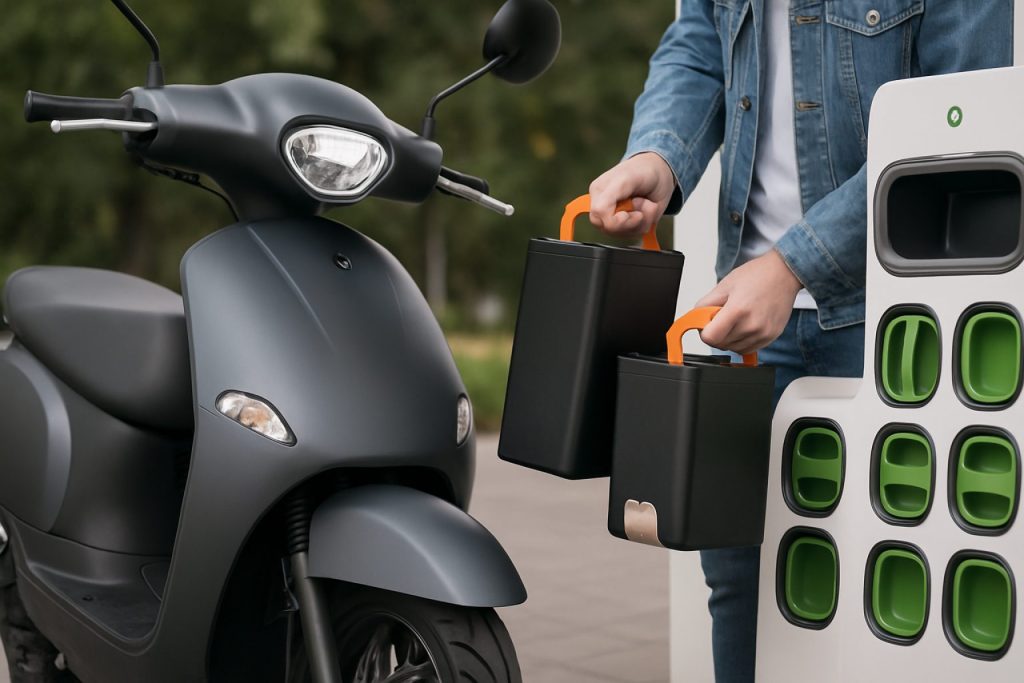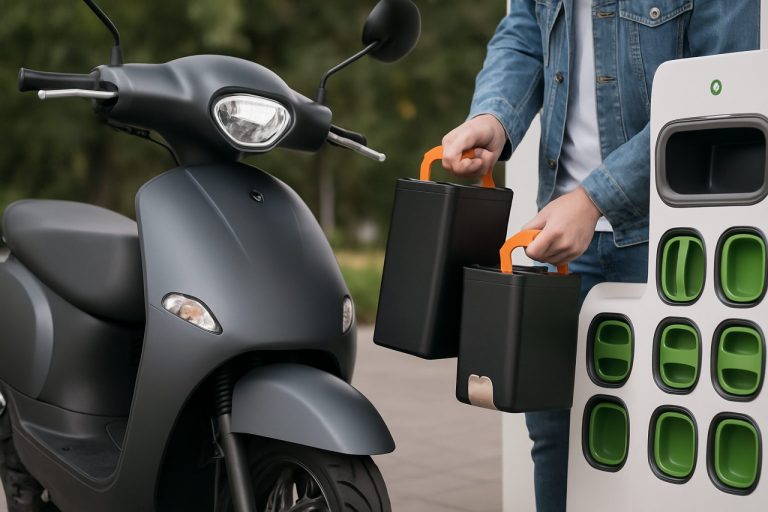
Battery Swapping Technology for Electric Two-Wheelers in 2025: Market Dynamics, Growth Projections, and Strategic Insights for the Next 5 Years
- Executive Summary & Market Overview
- Key Technology Trends in Battery Swapping for Two-Wheelers
- Competitive Landscape and Leading Players
- Market Size, Growth Forecasts, and CAGR Analysis (2025–2030)
- Regional Market Analysis: Opportunities and Hotspots
- Challenges, Risks, and Barriers to Adoption
- Opportunities and Strategic Recommendations
- Future Outlook: Innovations and Market Evolution
- Sources & References
Executive Summary & Market Overview
Battery swapping technology for electric two-wheelers is rapidly emerging as a transformative solution to address the challenges of range anxiety, long charging times, and infrastructure limitations in the electric mobility sector. This technology enables users to quickly exchange depleted batteries for fully charged ones at dedicated swapping stations, significantly reducing vehicle downtime and enhancing operational efficiency. As of 2025, the global market for battery swapping in electric two-wheelers is witnessing robust growth, driven by increasing urbanization, government incentives for electric vehicle (EV) adoption, and the proliferation of shared mobility services.
According to recent market analyses, the battery swapping market for electric two-wheelers is projected to reach a valuation of over USD 1.7 billion by 2025, with a compound annual growth rate (CAGR) exceeding 25% from 2022 to 2025. Key growth regions include Asia-Pacific, particularly China and India, where high population density and a large base of two-wheeler users create favorable conditions for rapid deployment. In India, government initiatives such as the FAME II scheme and policy frameworks supporting battery-as-a-service (BaaS) models are accelerating adoption rates NITI Aayog. China continues to lead in terms of infrastructure rollout and user base, with companies like NIU Technologies and Gogoro expanding their networks aggressively.
Major industry players are investing in standardized battery platforms and interoperable swapping networks to enhance user convenience and reduce operational costs. Strategic partnerships between OEMs, battery manufacturers, and energy providers are further catalyzing market expansion. For instance, Hero MotoCorp and Gogoro have announced joint ventures to establish large-scale swapping infrastructure in key urban centers.
Despite the positive outlook, the market faces challenges such as the need for standardization, high initial infrastructure costs, and regulatory uncertainties in some regions. However, ongoing technological advancements, supportive policy measures, and the growing demand for sustainable urban mobility are expected to drive continued growth and innovation in the sector through 2025 and beyond International Energy Agency.
Key Technology Trends in Battery Swapping for Two-Wheelers
Battery swapping technology for electric two-wheelers is rapidly evolving, driven by the need for faster charging, operational efficiency, and enhanced user convenience. As of 2025, several key technology trends are shaping the landscape of battery swapping for electric scooters and motorcycles.
- Standardization of Battery Packs: Industry players are increasingly collaborating to develop standardized battery formats, enabling interoperability across different brands and models. This trend is exemplified by initiatives such as the Swappable Batteries Motorcycle Consortium, which includes major OEMs like Honda, Yamaha, KTM, and Piaggio. Standardization reduces infrastructure complexity and accelerates network expansion.
- Smart Battery Management Systems (BMS): Advanced BMS are being integrated into swappable batteries, offering real-time monitoring of battery health, usage patterns, and predictive maintenance. Companies like Gogoro are leveraging AI and IoT to optimize battery performance and extend lifecycle, ensuring safety and reliability for end-users.
- Automated and Modular Swapping Stations: The deployment of fully automated swapping stations is gaining momentum, reducing swap times to under a minute and minimizing human intervention. Modular station designs allow for scalable deployment in urban and peri-urban areas, as seen in the expansion strategies of SUN Mobility and Gogoro.
- Integration with Digital Platforms: Battery swapping networks are increasingly integrated with mobile apps and digital payment systems, enabling seamless user experiences. Real-time station availability, reservation systems, and subscription-based models are being adopted by providers such as Bounce Infinity and Gogoro.
- Second-Life and Circular Economy Initiatives: As battery swapping networks scale, there is a growing focus on repurposing used batteries for stationary storage and other applications. Companies are partnering with energy firms to create closed-loop systems, reducing environmental impact and enhancing sustainability, as highlighted by Gogoro’s partnership with Enel X.
These technology trends are expected to accelerate adoption, improve user confidence, and support the broader electrification of two-wheeler fleets in key markets such as India, Southeast Asia, and Europe through 2025 and beyond.
Competitive Landscape and Leading Players
The competitive landscape for battery swapping technology in the electric two-wheeler segment is rapidly evolving, driven by increasing urbanization, government incentives, and the need for efficient charging solutions. By 2025, the market is characterized by a mix of established energy companies, innovative startups, and strategic partnerships with two-wheeler manufacturers. Key players are focusing on expanding their swapping station networks, enhancing interoperability, and developing standardized battery modules to capture a larger share of the growing electric mobility market.
Among the leading players, Gogoro stands out as a pioneer, particularly in Taiwan and expanding into Southeast Asia and India. Gogoro’s open battery swapping platform and partnerships with major OEMs like Hero MotoCorp have enabled rapid deployment of its GoStation network, which is projected to exceed 10,000 stations globally by 2025. The company’s focus on modular, swappable batteries and real-time network management provides a scalable model for urban mobility.
In India, SUN Mobility and Bounce Infinity are prominent, leveraging collaborations with local two-wheeler manufacturers and fleet operators. SUN Mobility’s interoperable battery swapping infrastructure, supported by investments from Bosch and Indian Oil Corporation, is targeting deployment in over 20 cities by 2025. Bounce Infinity, meanwhile, is integrating its swapping stations with its own electric scooter offerings and third-party fleets, aiming for a network of 3,000+ stations.
- NIO (China) is expanding its Power Swap stations for two-wheelers, leveraging its expertise from the electric car segment and targeting urban delivery fleets.
- Ola Electric is piloting battery swapping in select Indian cities, with plans for a nationwide rollout in partnership with local vendors and logistics companies.
- Ampere Vehicles and Ather Energy are exploring swapping solutions, though their primary focus remains on fast-charging networks.
Strategic alliances are shaping the competitive dynamics, with companies like Yamaha Motor, Honda, and Piaggio forming consortia to develop standardized swappable battery systems for global markets. The push for interoperability and open platforms is expected to intensify competition, lower costs, and accelerate adoption, especially in densely populated urban centers across Asia and Europe.
Market Size, Growth Forecasts, and CAGR Analysis (2025–2030)
The global market for battery swapping technology in electric two-wheelers is poised for robust expansion between 2025 and 2030, driven by accelerating urbanization, government incentives, and the rapid adoption of electric mobility solutions. In 2025, the market size is projected to reach approximately USD 1.2 billion, with Asia-Pacific—particularly China and India—dominating due to their vast two-wheeler user base and supportive regulatory frameworks. By 2030, the market is forecasted to surpass USD 4.5 billion, reflecting a compound annual growth rate (CAGR) of around 30% during the forecast period Mordor Intelligence.
Key growth drivers include the need to reduce vehicle downtime, the high cost of battery ownership, and the push for sustainable urban transport. Battery swapping addresses range anxiety and charging time concerns, making it particularly attractive for commercial fleets and last-mile delivery operators. The proliferation of shared mobility services and the entry of major players such as Gogoro, SUN Mobility, and Ola Electric are further catalyzing market growth through strategic partnerships and network expansion.
- Asia-Pacific: Expected to account for over 70% of the global market by 2025, with China leading in infrastructure deployment and India witnessing rapid pilot project scaling. Government initiatives, such as FAME II in India, are incentivizing both OEMs and battery swapping operators India Brand Equity Foundation.
- Europe: Growth is moderate but accelerating, especially in urban centers with strong e-mobility policies. Pilot projects in countries like the Netherlands and France are laying the groundwork for broader adoption International Energy Agency.
- Rest of World: Latin America and Southeast Asia are emerging markets, with local governments exploring battery swapping as a solution to urban congestion and pollution.
Looking ahead, the market’s CAGR is expected to remain above 25% through 2030, contingent on continued investment in infrastructure, standardization of battery formats, and favorable policy environments. The entry of automotive OEMs and energy companies into the battery swapping ecosystem is likely to further accelerate market maturity and scale MarketsandMarkets.
Regional Market Analysis: Opportunities and Hotspots
The regional landscape for battery swapping technology in electric two-wheelers is rapidly evolving, with Asia-Pacific (APAC) emerging as the dominant hotspot in 2025. This region, led by China and India, is witnessing accelerated adoption due to high urban population density, government incentives, and a robust two-wheeler market. In China, battery swapping networks are expanding aggressively, supported by both public and private sector initiatives. Companies such as NIO and Aulton are scaling up their infrastructure, with hundreds of swap stations already operational in major cities. The Chinese government’s push for standardization and interoperability is further catalyzing market growth, making China the global leader in battery swapping for two-wheelers.
India represents another significant opportunity, driven by its vast two-wheeler user base and urban congestion challenges. The Indian government’s Faster Adoption and Manufacturing of Electric Vehicles (FAME) scheme, along with state-level policies, is incentivizing both consumers and infrastructure providers. Startups like Bounce Infinity and SUN Mobility are deploying modular battery swapping stations in key urban centers, targeting last-mile delivery fleets and ride-sharing services. According to Mordor Intelligence, India’s battery swapping market is projected to grow at a CAGR exceeding 30% through 2025, with metropolitan areas such as Delhi, Bangalore, and Mumbai identified as early adoption hotspots.
In Southeast Asia, countries like Indonesia, Vietnam, and Thailand are also emerging as promising markets. The prevalence of two-wheelers as primary urban transport, combined with government-led electrification targets, is spurring pilot projects and partnerships. For instance, Gogoro has entered the Indonesian market through collaborations with local energy and mobility providers, aiming to replicate its successful Taiwanese model. The region’s fragmented regulatory environment, however, poses challenges for rapid scaling.
Outside APAC, Europe is witnessing nascent but growing interest, particularly in Southern and Eastern European cities where two-wheelers are popular. Pilot programs in Italy and Spain, supported by local governments and companies like Swapfiets, are testing the viability of battery swapping for urban mobility. However, the market remains in its infancy compared to Asia.
In summary, 2025’s key opportunities for battery swapping in electric two-wheelers are concentrated in Asia-Pacific, with China and India as clear leaders, while Southeast Asia and select European cities represent emerging hotspots. Market growth is closely tied to supportive policies, urbanization trends, and the scale of two-wheeler usage in each region.
Challenges, Risks, and Barriers to Adoption
Battery swapping technology for electric two-wheelers presents a promising solution to address range anxiety and reduce charging downtime. However, its widespread adoption faces several significant challenges, risks, and barriers as of 2025.
- Standardization Issues: The lack of standardized battery sizes, connectors, and communication protocols among manufacturers remains a major hurdle. Without industry-wide standards, interoperability between different brands and swapping stations is limited, restricting user convenience and network scalability. Efforts by organizations such as the Society of Indian Automobile Manufacturers and the International Energy Agency highlight the need for harmonized standards, but progress is slow due to competitive interests and proprietary technologies.
- High Initial Infrastructure Costs: Establishing a robust battery swapping network requires significant capital investment in swapping stations, battery inventory, and backend management systems. According to Bain & Company, the upfront costs and ongoing operational expenses can deter new entrants and slow network expansion, especially in regions with low electric two-wheeler penetration.
- Battery Ownership and Lifecycle Management: The shift from vehicle ownership to battery-as-a-service models introduces complexities in battery tracking, maintenance, and end-of-life recycling. Ensuring consistent battery quality and safety across a shared pool is challenging, as highlighted by McKinsey & Company. Additionally, managing battery degradation and liability in case of malfunction or accidents remains a legal and operational risk.
- Regulatory and Safety Concerns: Regulatory frameworks for battery swapping are still evolving. Governments are working to address safety standards, data privacy, and consumer protection, but inconsistent policies across regions create uncertainty for operators and investors. The NITI Aayog in India, for example, has proposed guidelines, but implementation and enforcement vary at the state level.
- User Acceptance and Behavioral Barriers: Consumer trust in the reliability, safety, and convenience of battery swapping is not yet universal. Concerns about battery quality, theft, and compatibility can deter adoption, especially among early-stage markets. Education and awareness campaigns are needed to build confidence and drive behavioral change.
Addressing these challenges will require coordinated efforts among manufacturers, policymakers, and service providers to unlock the full potential of battery swapping technology for electric two-wheelers in 2025 and beyond.
Opportunities and Strategic Recommendations
The battery swapping technology market for electric two-wheelers is poised for significant growth in 2025, driven by increasing urbanization, government incentives, and the need for rapid, convenient charging solutions. As electric two-wheelers become a preferred mode of transport in densely populated regions, particularly in Asia-Pacific, battery swapping addresses key pain points such as long charging times and range anxiety. This creates substantial opportunities for both established players and new entrants.
Key opportunities include:
- Expansion in Emerging Markets: Countries like India, Indonesia, and Vietnam are witnessing rapid adoption of electric two-wheelers. Battery swapping networks can scale quickly in these markets due to high population density and the prevalence of two-wheelers. Companies such as SUN Mobility and Gogoro are already piloting and expanding their networks in these regions.
- Partnerships with OEMs and Fleet Operators: Collaborations between battery swapping service providers and original equipment manufacturers (OEMs) or last-mile delivery fleets can accelerate adoption. For instance, Gogoro has partnered with major OEMs in Taiwan and India to integrate swappable batteries into their vehicle designs.
- Standardization and Interoperability: There is a growing push for standardized battery formats and interoperable swapping stations, which can reduce infrastructure costs and increase user convenience. Industry alliances and government initiatives, such as those led by NITI Aayog in India, are working towards these standards.
- Integration with Renewable Energy: Battery swapping stations can be co-located with renewable energy sources, enabling green charging and reducing grid dependency. This aligns with sustainability goals and can attract ESG-focused investments.
Strategic recommendations for stakeholders in 2025 include:
- Invest in Scalable Infrastructure: Prioritize modular, easily deployable swapping stations in urban centers and high-traffic corridors to maximize utilization and visibility.
- Foster Ecosystem Partnerships: Engage with OEMs, energy providers, and government agencies to create a robust ecosystem that supports interoperability and policy alignment.
- Leverage Data Analytics: Utilize real-time data from swapping stations to optimize operations, predict demand, and enhance user experience.
- Focus on User Education and Incentives: Launch awareness campaigns and offer incentives to accelerate user adoption, particularly in markets with low EV penetration.
With the right strategies, battery swapping technology can become a cornerstone of sustainable urban mobility for electric two-wheelers in 2025 and beyond, as highlighted by recent analyses from IDC and Bain & Company.
Future Outlook: Innovations and Market Evolution
The future outlook for battery swapping technology in the electric two-wheeler segment is marked by rapid innovation and evolving market dynamics, particularly as the industry approaches 2025. Key players are investing in advanced battery management systems, modular battery designs, and interoperable swapping infrastructure to address persistent challenges such as range anxiety, long charging times, and high upfront costs.
One of the most significant innovations anticipated by 2025 is the standardization of battery packs and swapping protocols. Industry alliances and government bodies in markets like India and Southeast Asia are working towards interoperability standards, which will allow batteries from different manufacturers to be swapped at common stations. This is expected to accelerate adoption by reducing consumer concerns about compatibility and availability of swapping stations. For instance, the Indian government’s draft battery swapping policy aims to create a unified framework for battery swapping networks, which could serve as a model for other emerging markets (NITI Aayog).
Technological advancements are also driving down the cost of battery packs and improving their energy density, making battery swapping more economically viable for both operators and end-users. Companies like Gogoro and SUN Mobility are pioneering compact, lightweight battery modules and AI-driven network management systems that optimize battery distribution and station uptime. These innovations are expected to enhance user experience and operational efficiency, further fueling market growth.
From a market evolution perspective, the battery swapping ecosystem is likely to see increased participation from traditional energy companies, urban mobility startups, and even e-commerce platforms seeking to electrify their delivery fleets. Strategic partnerships and joint ventures are anticipated to proliferate, as seen in recent collaborations between OEMs and battery service providers in Asia (Honda, Hero Electric).
By 2025, analysts project that battery swapping could account for a significant share of the electric two-wheeler charging market in densely populated urban centers, particularly in Asia-Pacific. According to IDC, the Asia-Pacific region is expected to lead global adoption, driven by supportive policies, high urbanization rates, and the proliferation of shared mobility services. As the technology matures, further integration with digital payment platforms and IoT-enabled tracking will likely enhance the scalability and convenience of battery swapping solutions.
Sources & References
- NITI Aayog
- NIU Technologies
- Gogoro
- International Energy Agency
- SUN Mobility
- SUN Mobility
- Bosch
- NIO
- Ola Electric
- Ampere Vehicles
- Yamaha Motor
- Piaggio
- Mordor Intelligence
- India Brand Equity Foundation
- MarketsandMarkets
- Aulton
- Society of Indian Automobile Manufacturers
- Bain & Company
- McKinsey & Company
- IDC



